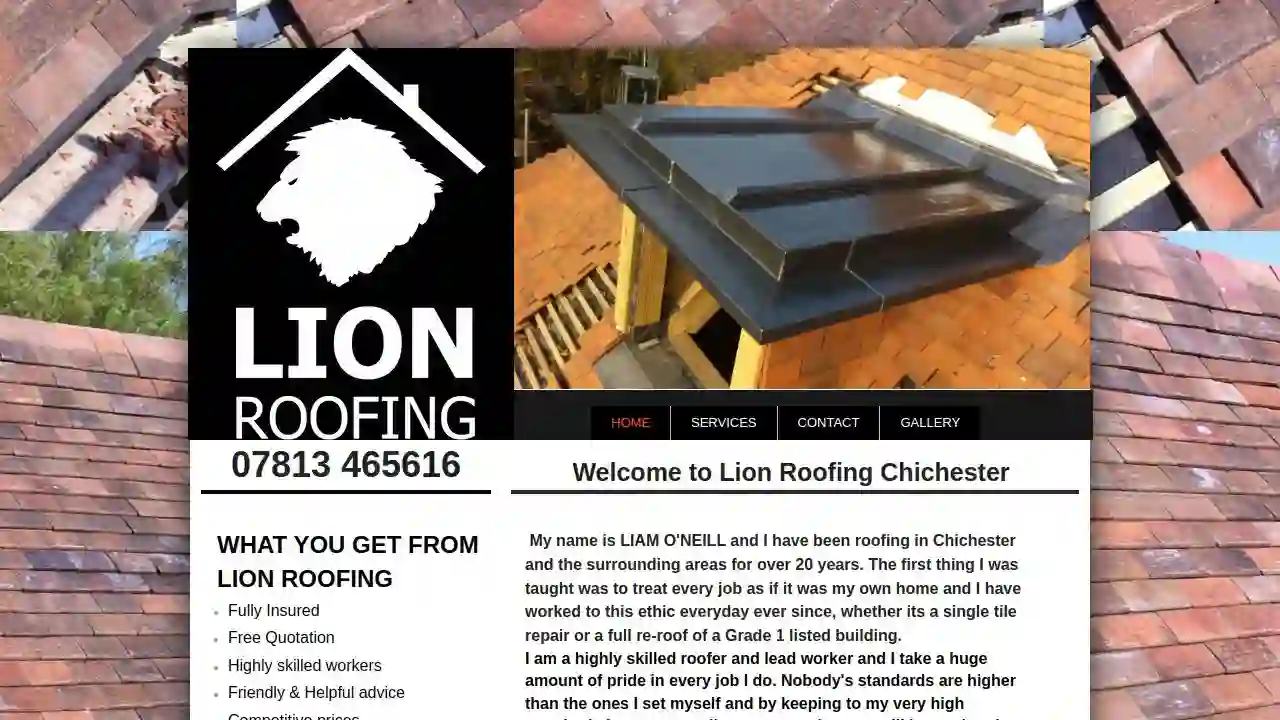
My name is LIAM O'NEILL and I have been roofing in Chichester and the surrounding areas for over 20 years. The first thing I was taught was to treat every job as if it was my own home and I have worked to this ethic everyday ever since, whether its a single tile repair or a full re-roof of a Grade 1 listed building. I am a highly skilled roofer and lead worker and I take a huge amount of pride in every job I do. Nobody's standards are higher than the ones I set myself and by keeping to my very high standards I can personally guarantee that you will be getting the best job possible if you decide to use Lion Roofing.
WHAT YOU GET FROM LION ROOFING
- Fully Insured
- Free Quotation
- Highly skilled workers
- Friendly & Helpful advice
- Competitive prices
- We only use the best materials
- Very high standard of work
- Over 25 years of roofing experience
I have been roofing in Chichester and the surrounding areas for over 20 years. The first thing I was taught was to treat every job as if it was my own home and I have worked to this ethic everyday ever since, whether its a single tile repair or a full re-roof of a Grade 1 listed building. I am a highly skilled roofer and lead worker and I take a huge amount of pride in every job I do. Nobody's standards are higher than the ones I set myself and by keeping to my very high standards I can personally guarantee that you will be getting the best job possible if you decide to use Lion Roofing.
Single-ply flat roof systems are getting increasingly more popular in UK construction projects for both new builds and refurbishments. PVC single-ply membranes have been around since the 1960's but have only recently started to be used on domestic properties. The single-ply membrane is welded together with a hot air gun so there are no naked flames during the installation. Single-ply membranes are integrated with UV resistors at source during the manufacturing process therefore providing superior UV degradation resistance. Single-ply membranes are fire resistant and self-extinguishing and because of this they can not be ignited by flying sparks i.e. cigarette butts. The membranes flexibility has been tested to temperatures below -30ºC and in a advanced weather conditions test the membranes have been given a life expectancy of 25-40 years. Personally I've never liked flat roofing systems (apart from lead) but the company I worked for started using single-ply and at first I was sceptical but the more we used it the more I liked it, it looks good and we've never had a single problem with the system in fact I use Cefil UK single membranes and they have sold over 3,000,000 m² and not had one product failure.
Chimneys first started appearing in the 12th century but didn't become common until the late 18th century. There are some outstanding chimneys from the Georgian and Victorian periods with detailed brickwork and skilled leadwork. 7 out of 10 leaks I attend are chimney related whether it's the lead flashing that needs replacing, porous bricks, perished mortar joints or just needing a cowl installed. Even though I would class a chimney as a weak point on a roof, I think a roof looks odd without one and I'm not the only one that thinks this, new builds are having "fake" chimneys installed whether it's in keeping with the surrounding area or just the architects preference. They are made out of fibreglass and have about 30mm thick bricks stuck to the shell, the mortar joints are pointed in on the floor then they are craned into position then bolted into the rafters. I have pictures in my gallery of some I have done and afterwards you wouldn't know that they weren't real.
Lead is indisputably one of the greatest building materials. For proof all you have to do is look up at countless historical buildings throughout the UK. If installed correctly by an experienced leadworker lead can last in excess of 100 years. Lead is the softest of the common metals with a melt
- Fully Insured
- Free Quotation
- Highly skilled workers
- Friendly & Helpful advice
- Competitive prices
